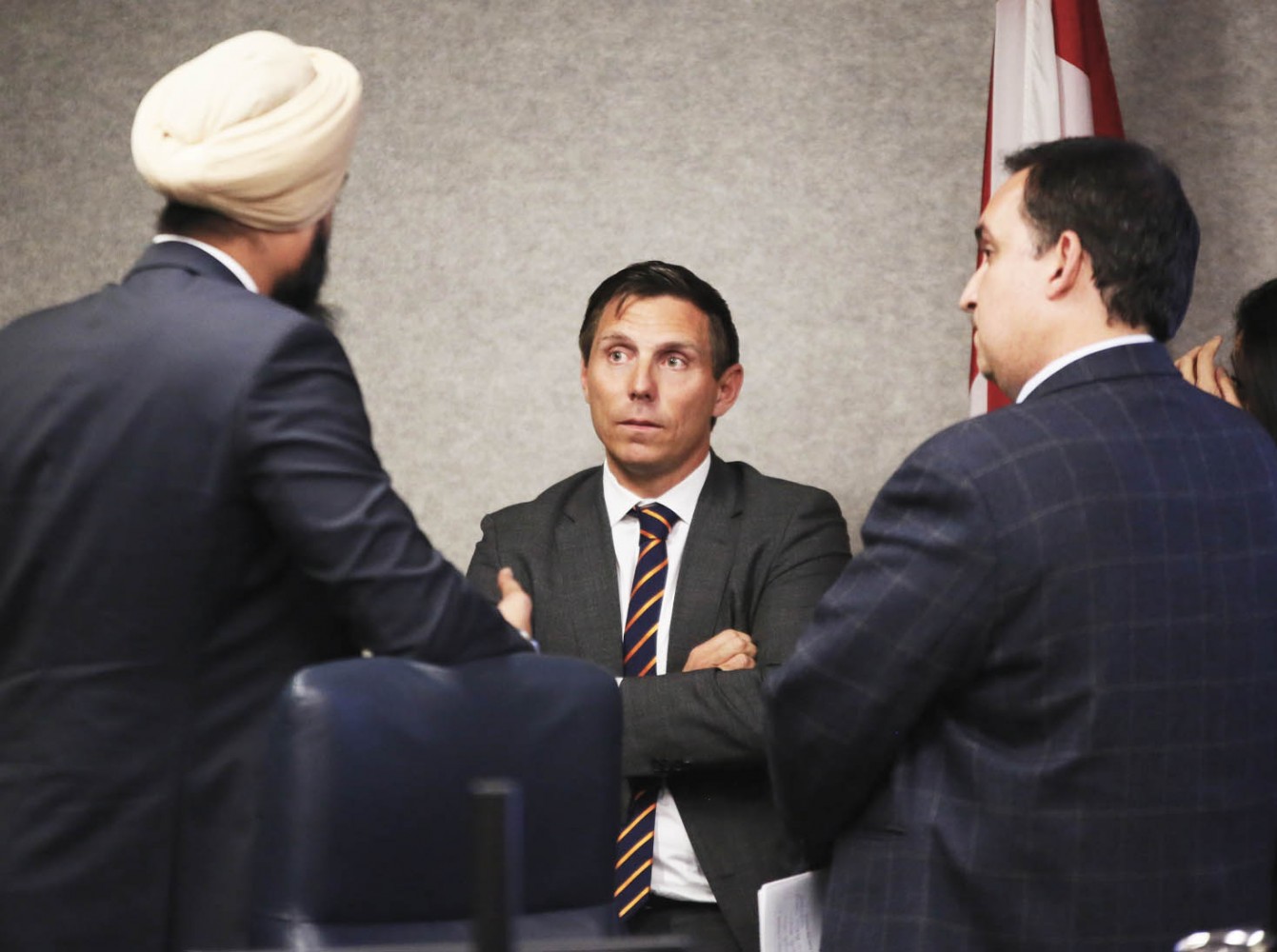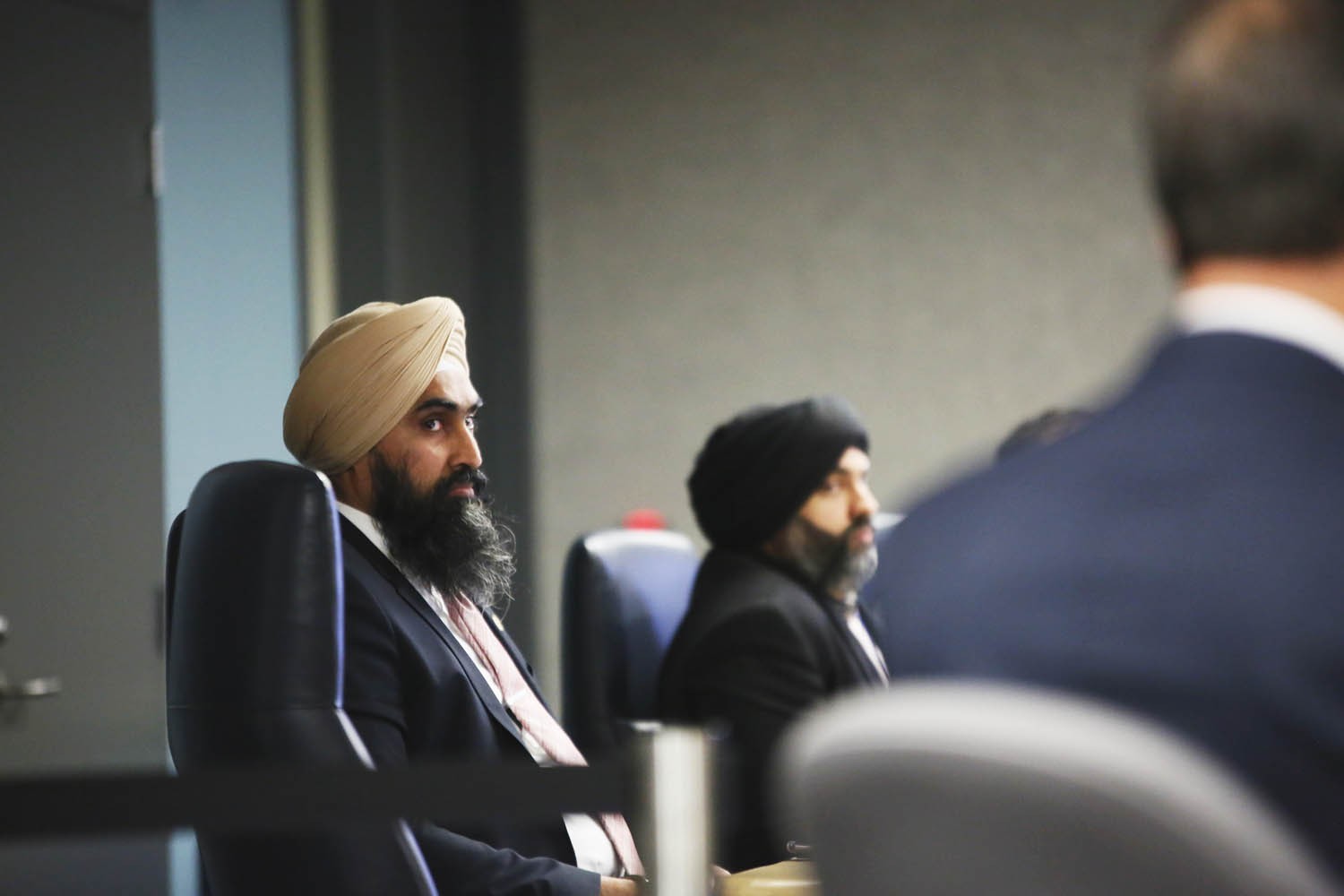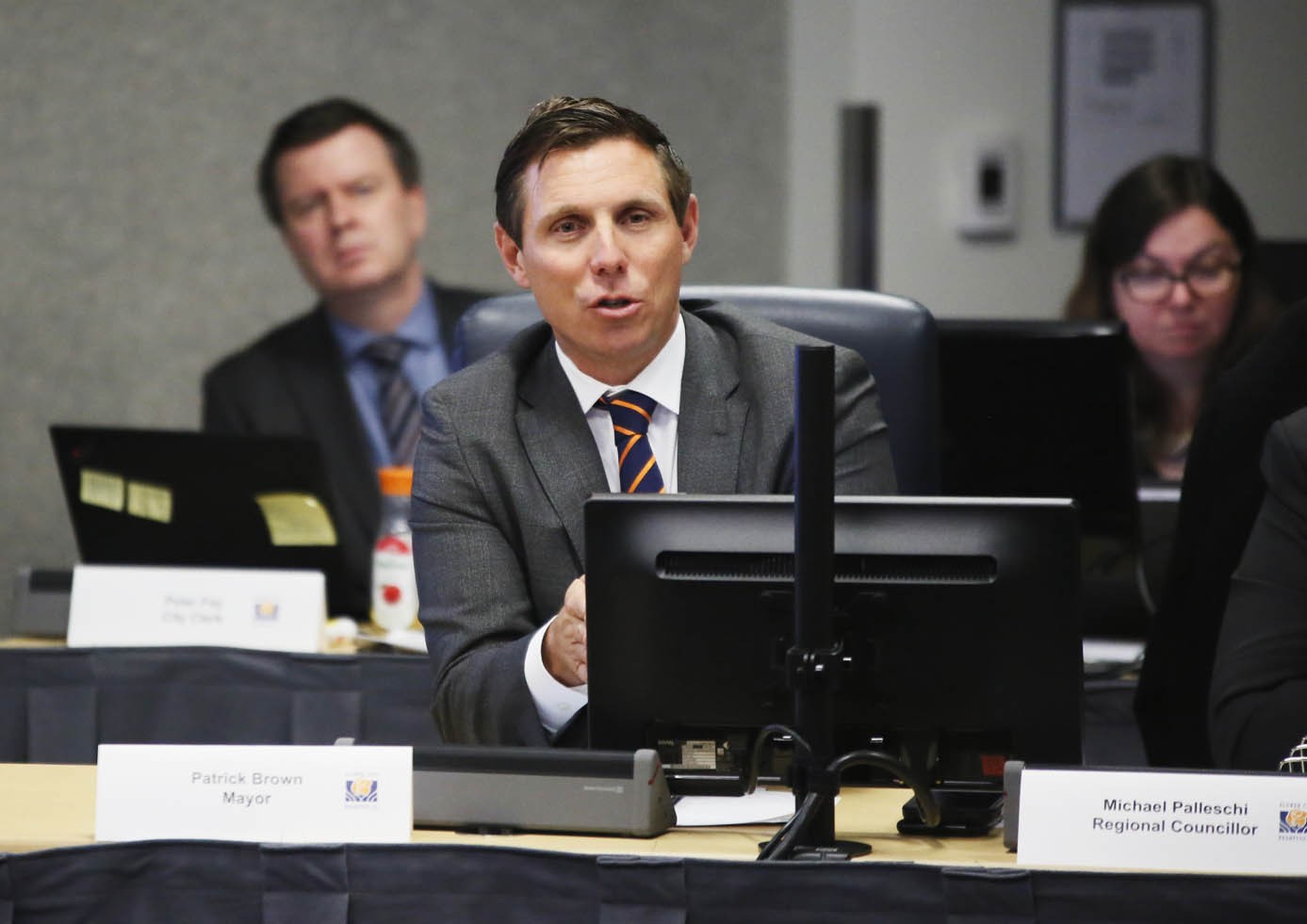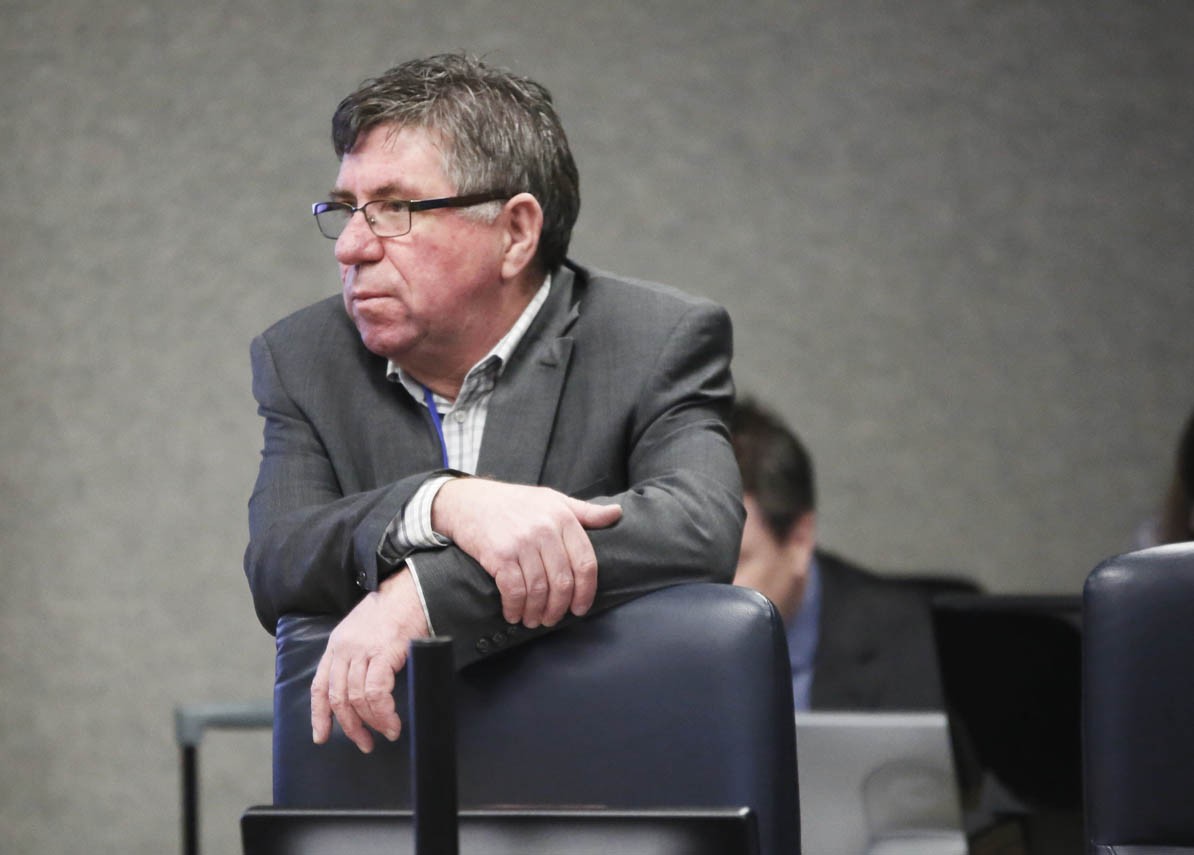
LRT debate drives wedge into council once again
Unity and teamwork?
The debate on the future of light rail transit in Brampton has once again landed like a bomb two days into the new council term, drawing frustration from councillors and perhaps new battle lines over a question that plagued the previous council.
After the last two councils defeated a Main Street LRT route, that is the alignment now moving forward, with two alternatives scrapped Wednesday by the brand new council, all of it pending ratification next week.
While discussion eventually reached a compromise, a final decision could see the city’s hoped-for LRT realigned once again along the controversial Main Street corridor, which was at the heart of a deep division in council over the past four years.
Councillor Gurpreet Dhillon, speaking during the first committee of council meeting on Wednesday, introduced a motion to put the Main Street route back on the table as Brampton’s preferred option and start lobbying other levels of government to get funding to move the proposal forward.
That was the sole route former mayor Linda Jeffrey was willing to accept, which she made clear during her recent election campaign, but it was twice before rejected by council. Its resurrection raises questions about the fate of the previous council’s decision to spend $4.4 million studying alternative routes along Kennedy and McLaughlin Roads.
Dhillon’s motion met with strong resistance from Mayor Patrick Brown, who campaigned on a different set of transit options outlined in the Brampton 2040 Vision document, which did not include a Main Street proposal.

Councillor Gurpreet Dhillon
Brown labelled Dhillon’s motion as “short-sighted” and likely to stoke division in a council that is trying to leave the past behind.
“If we’re going to have a major discussion … we shouldn’t do it on a napkin at the last minute,” he said.
The lack of harmony that plagued the previous council, which many attributed to the LRT debate, was the reason senior governments didn’t take Brampton seriously as a place to put tax dollars, Brown said.
“I can tell you that people looked at the mess that happened in Brampton and there wasn’t a lot of interest in investing,” he said.
Brown was vehement that to attract money to build higher-order transit, the entire community needs to be behind the project. Further, the city needs to think bigger, possibly even think about tunneling below downtown, to reach a consensus between those who want the LRT to reach into the city core, and those who worry about destroying heritage aspects of the city centre.
Brown questioned the wisdom of putting forward the same request that council rejected in 2015, when the province had offered to fully fund the LRT into downtown as part of the $1.6-billion Hurontario LRT project—which he called a “squandered opportunity.”
He added that he’s already had discussions with Prime Minister Justin Trudeau about delivering transit proposals to the federal government.

Mayor Patrick Brown
“This is too important to rush and get it wrong,” he said. “You don’t make major transit changes on a whim. That’s when mistakes happen.”
However, the scales were tipped against Brown from the start of the discussion, as Councillors Rowena Santos, Martin Medeiros and Paul Vicente all came out in support of Dhillon’s motion.
In 2015, Medeiros and Dhillon, along with Councillor Pat Fortini, voted for the Main Street LRT along with Jeffrey. It’s no surprise to see Santos and Vicente voting with the departed Jeffrey’s old allies, as both councillors openly campaigned in support of the former mayor during the fall election period.
Vicente attempted to counter Brown’s criticisms by saying that reintroducing the Main Street LRT option would be “an opportunity for us to get our fair share” and that waiting would risk missing an opportunity.
The Main Street alignment is about a quarter of the LRT route’s distance in Mississauga, which the province is currently committed to fund. The former Liberal government announced after Brampton turned down the provincially approved Main Street alignment in 2015 that funding for the city's portion of the LRT was being pulled and put into a pool for future transit projects across the Greater Toronto and Hamilton Area. It's not clear if the PC government will restore funding if the Main Street option moves forward. The Doug Ford government has not confirmed that it will honour the Hurontario LRT funding commitment by the previous government.
“I think this is what Brampton wanted; that’s why we have this mandate here in this council to move the city forward,” Vicente said Wednesday.
Brown received backing from Councillor Doug Whillans, who labelled the motion as a rehashing of an already failed plan.
Councillor Jeff Bowman had much stronger words for fellow councillors, deeming their campaign talk of forming a united front and leaving the past behind “B.S.”
“We are sending a message out to Ontario … that again we’re a divided council,” he said.
In a failed attempt to pump the brakes, Brown tried to have the motion referred to the city’s transit committee. That body currently doesn’t exist, but it will most likely be struck during council’s meeting next week.
That move was supported by Councillor Michael Palleschi, who noted that while he wanted to support Dhillon’s motion, there was no harm in taking time to do proper research and due diligence before making major changes to the city’s transit plan. He said putting it back to committee for debate could allow for council and community members to get on the same page and present a unified front to the upper levels of government.
Brown, who has experience in both Ottawa, as an MP, and Queen’s Park, as an MPP and leader of the PCs, stressed that the community and council need to come together if they want to see support for big capital projects in the future.

Councillor Doug Whillans
“You take a project to senior levels of government that doesn’t have a unifying presence in the community, you’ve wasted and squandered an opportunity,” he said.
City CAO Harry Schlange noted that there may be more options; through staff work currently being done to study routes along McLaughlin and Kennedy, “there are some new ideas shaping up.”
Initially, Dhillon was hesitant to alter his motion, claiming the Main Street alignment offered a “comprehensive plan” and didn’t preclude the possibility of tunnelling transit under downtown.
He also countered that the Main Street route was not a divisive issue, claiming that 75 percent of Bramptonians were in favour of the route. That’s a number frequently touted by Jeffrey in 2015 from a mysterious survey, the origins and methodologies of which were unknown and never explained.
A survey of 999 Brampton residents commissioned by The Pointer and completed by Forum Research found that support for the Main Street route was much lower. Of the roughly 60 percent who supported an LRT at all, 40 percent of those respondents chose the Main Street route, with 19 percent supporting McLaughlin, 17 percent choosing Kennedy, and 24 percent looking for a different route altogether. That suggests only about 25 percent of the city's residents would like to see an LRT on Main Street.
Council stepped away from the committee table for two separate recesses as the motion lingered. Eventually, after the tension had eased, Brown was able to introduce wording into Dhillon’s motion to allow the tunnelling option to be considered.
The motion then carried unanimously, including provisions to stop considering Kennedy or McLaughlin as potential routes for an LRT and instead focus on aligning Bus Rapid Transit (BRT) along those thoroughfares.
Dhillon refused to comment further to The Pointer on the motion after the debate.
Palleschi acknowledged the tone of the argument was unfortunate, but was happy to see it end in a compromise that appeared to please both sides.
“I think we've always talked a lot about working together and putting the past behind us, so for us to be able to give the mayor the opportunity — and that sober second thought — if they want the LRT down into the downtown, then I think we'll have more council members supporting” it, Palleschi said. “He's talked to Trudeau, he's talked to other levels of government, we should at least give him that opportunity to be able to deliver.”
The debate was reminiscent of last term’s division, Palleschi acknowledged, but it will fall to Brown to ensure things don’t continue down that path.
“Last council, we had seven members of council that typically got along and put forward things they thought were good for the community, and then we had some members that didn't think that it was.” This council has that potential for more of the same, he said, “but that's up to the mayor to see if he can rally the troops.”
Santos said she was encouraged, despite the obvious tension in the room.
“What we do see here is people are talking to each other and really trying to find common ground. I think that’s really a strong move for progress and moving forward,” she said.
Routing higher-order transit along Main Street has been a question mark for successive city councils, with the additional concern that the area lies in a flood plain.
The Hurontario-Main LRT project was conceived in 2008 in Ontario’s Big Move report, listed as a priority within the first 15 years of the plan. In its original incarnation, the route would connect Port Credit in the south to Brampton’s downtown in the north, and was designed to serve what the Metrolinx plan billed as “intensification corridors.”
After the meeting Brown spoke to The Pointer, clearly frustrated by what had unfolded.
“So what we've had over the past couple of months is a divided council. A divided city on the issue of modern transit. I felt that we shouldn't fall back into the same old debates and that we needed to unite the community and unite the council,” he said.
Brown added that the appearance of division was a bad message to send to a city that voted for change.
“I didn't want to see a 6-5 motion, I wanted to see an 11-0 motion. I wanted a transit motion that did not divide us but excites us and inspires us. I was relieved that there was finally —after much argument — openness to working together. The tunneling option appeared to be the means to unite various aspects of this debate.”
He repeated his concerns about securing money for a project.
“We're never going to get federal funding, we're never going to get provincial funding, if we're divided, if there is a project that looks divisive, that lacks support in the community. … If we're going to fix transportation for a generation, we don't need a band-aid solution, we need the right solution, and tunneling through downtown alleviates the concerns that existed that we would rip up a historic area of the city.”
Brown seemed fixed on the need to change course.
“If we are a divided city, why would a provincial-federal government put in investment into an issue that would cause strain? They want a win. This is about getting a major investment.”
The double-barrelled LRT track originally conceived by the province would have provided a 45-minute trip from Port Credit to downtown Brampton, and was projected to boost property values along the route between two and four percent within 500 metres of each of the 22 proposed stops, about three-quarters of them in Mississauga. It would create thousands of jobs throughout the construction process. Perhaps most important, it would provide a $1.8-billion economic uplift to the area by 2031, gauged by the attractiveness of alternative modes of transit to prospective GTHA dwellers.
“This is too important to rush and get it wrong...You don’t make major transit changes on a whim. That’s when mistakes happen.”
Mayor Patrick Brown
The sales-pitch was a good one, and originally it appeared that the City of Brampton was behind the idea.
The route was incorporated as part of the Hurontario/Main Street Corridor Master Plan approved by council in 2010. LRT into downtown Brampton was also recommended as part of the city’s 2011 Hurontario-Main Street Corridor Secondary Plan.
In April 2015, the province committed to providing the $1.6 billion required to connect Mississauga’s lakeshore to downtown Brampton, along the route initially envisioned in 2008.
Council infighting began almost immediately, the battle lines being drawn between two camps: one in favour of the route, led by Jeffrey, and the other, opponents who argued for a “made in Brampton” route that would not cut through and compromise the city’s historic downtown heritage district.
The public was also divided, and citizens’ voices and candour only added to the growing chasm inside council chambers.
Hesitancy about the Main Street route was reflected in a tentative 10-1 vote against it in September 2014. The final showdown came at the now infamous meeting in October 2015, when the route was turned down in a final acrimonious session inside the Rose Theatre that went past midnight.
Tired councillors and residents left that night thinking the debate, which had divided many in the city, was finally over. Three years later, it has been opened once again.
Submit a correction about this story


